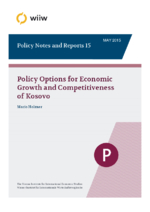Policy Options for Economic Growth and Competitiveness of Kosovo
wiiw Policy Note/Policy Report No. 15, May 2015
12 pages including 11 Figures
Summary
- Kosovo growth dynamics are encouraging but the level of economic activity is very low. Mass unemployment hints at macro-imbalances. Net transfers from migrants are pivotal for covering the huge trade balance deficit, as manufacturing exports are almost non-existent.
- Wages are low but increasing well ahead of productivity. The lack of an exchange rate policy is a substantial impediment. Transport infrastructure is of average, weak Balkan quality and the energy infrastructure is dismal, even for Balkan standards.
- The good news is that fiscal space is abundant and overall external indebtedness low as well.
- Apart from various institutional reforms, conventional policy recommendations comprise mostly supply-side measures that are effective in the medium to long run. These are similar to some of the following actions suggested.
- Export capacities should be increased via FDI support and the solution of the Trepca mine status. An improvement in market access to neighbouring countries and the EU is of utmost importance. Modern cross-border transport (especially rail) and energy infrastructure should be upgraded.
- The planned new coal-fired electricity plant and the refurbishment of the old blocks together with a powerful air pollution filter system are of crucial importance. Energy diversification via the redevelopment of the gas network and the improvement of power lines is another goal.
- Secondary education, specifically vocational training including an apprenticeship system, should be developed.
- A set of un-conventional policy recommendations for the short to medium run has the potential to more quickly increase aggregate demand and improve social conditions.
- Circular migration flows and return-migration should be facilitated and incentive schemes for remittances to go into business activities should be developed.
- Given the present current account constrained growth model of Kosovo, tax increases should target those with the highest income elasticity of demand for imports and government expenditures should involve as few imports as possible.
- Tax progressivity could be expanded in the corporate and personal income and real estate taxes. Additional luxury taxes on high-end import goods should be applied.
- A nationwide municipality housing project would solve the housing shortage and employ low-skilled with a comparatively low income elasticity of demand for imports. Moreover, local building materials such as cement and bricks could be used.
- Area-wide public transport should also have the goal to offer jobs to the less skilled as well as to substitute widespread individual car imports.
- A network of vocational training centres, health care centres, cultural and sports facilities could support local production as well as human capital and job creation.
- A comprehensive incomes policy with a centralised wage bargaining system needs to keep the average wage level on a longer-term productivity (cum inflation) growth path.
Reference to wiiw databases: wiiw Annual Database
Keywords: economic growth, competitiveness, industrialisation, infrastructure, economic policy, Kosovo
JEL classification: F43, O11, O14, O18, O20
Countries covered: Kosovo
Research Areas: Macroeconomic Analysis and Policy, Labour, Migration and Income Distribution, International Trade, Competitiveness and FDI
